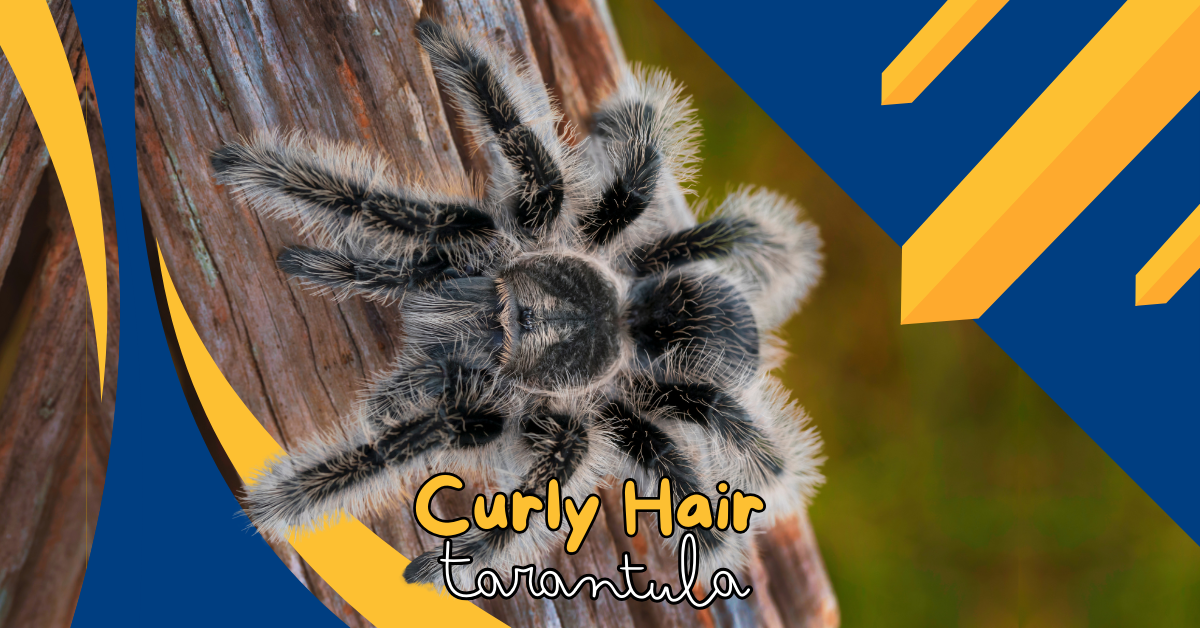1. Introduction to Curly Hair Tarantulas
The curly hair tarantula, scientifically known as Tliltocatl albopilosus, is a popular pet among spider enthusiasts due to its docile nature and unique appearance. Originating from Central America, these tarantulas are characterized by their curly, bristly hair that covers their bodies, giving them a distinct and somewhat fuzzy look. Known for being calm and relatively easy to care for, they make an excellent choice for beginners and experienced keepers alike. In this comprehensive guide, we will cover everything you need to know about curly hair tarantula care, diet, behavior, and more.
2. Curly Hair Tarantula Facts You Need to Know
Before delving into the care specifics, let’s explore some interesting facts about the curly hair tarantula:
- Appearance: Their most distinctive feature is their curly hair, which can be brown, tan, or golden. This unique feature makes them stand out among other tarantula species.
- Temperament: Known for their calm demeanor, they rarely display aggression, making them suitable for handling (with caution).
- Defensive Mechanism: They can flick urticating hairs from their abdomen when threatened, causing irritation to the skin and eyes.
- Habitat: These tarantulas are terrestrial and prefer to burrow. In the wild, they are found in tropical rainforests and savannas.
- Active Hours: They are primarily nocturnal, meaning they are most active during the night.
3. Lifespan and Size: What to Expect from a Curly Hair Tarantula
Curly hair tarantulas have a relatively long lifespan compared to other pets. Males typically live around 4-5 years, while females can live up to 10-15 years or even longer with proper care.
Size
Adult curly hair tarantulas have a leg span of approximately 4-6 inches. They start as tiny spiderlings but grow quickly during their first few years, reaching their full size by the time they are mature.
Growth and Molting
Molting is a crucial part of their growth process. During this time, they shed their old exoskeleton to make room for a new one. Molting can be a stressful period for the tarantula, and they may refuse food and become less active. It is essential to provide them with a safe and quiet environment during this time.
4. Setting Up the Perfect Enclosure for Your Curly Hair Tarantula
Creating a suitable habitat is vital for the health and well-being of your curly hair tarantula. Here’s what you need to set up the perfect enclosure:
Enclosure Size
A 5-10 gallon terrarium is ideal for an adult curly hair tarantula. It should be wider than it is tall to prevent injuries from falls, as they are ground-dwelling creatures.
Substrate
Use a deep layer of coconut fiber, peat moss, or a mixture of both as substrate. This allows them to burrow and provides a comfortable, natural environment. The substrate should be kept slightly damp but not wet.
Hides and Decorations
Provide at least one hiding spot, such as a piece of cork bark or a small hollow log, where your tarantula can retreat. This helps them feel secure and reduces stress.
Temperature and Humidity
Maintain a temperature range of 75-85°F (24-29°C) and a humidity level of around 65-75%. Use a heat mat if necessary, but avoid direct heating. A small water dish should always be available for humidity and drinking.
Lighting
Curly hair tarantulas do not require special lighting. Natural room light is sufficient. Avoid bright lights, as tarantulas are sensitive to light and prefer dim conditions.
5. Curly Hair Tarantula Diet: What and How to Feed
Feeding your curly hair tarantula a proper diet is essential for its health and longevity. Here’s what you need to know:
Diet
- Primary Food: Feed your tarantula a diet of gut-loaded crickets, roaches, and mealworms. These insects should be appropriately sized—about the same size as the tarantula’s abdomen.
- Occasional Treats: You can offer small vertebrates like pinky mice occasionally, but these are not necessary for a healthy diet and should be given sparingly.
- Feeding Schedule: Juveniles should be fed every 4-5 days, while adults can be fed once a week. Remove uneaten food after 24 hours to prevent mold and pests in the enclosure.
Water
Always provide a shallow water dish for hydration. Make sure to clean and refill it regularly to prevent bacterial growth.
6. Understanding Curly Hair Tarantula Behavior
Curly hair tarantulas are known for their calm and passive nature, making them ideal for observation and gentle interaction. Here are some typical behaviors:
Burrowing
These tarantulas love to dig and create burrows. This behavior helps them feel secure and is entirely natural.
Flicking Hairs
When threatened, they may use their back legs to flick urticating hairs as a defense mechanism. These hairs can cause irritation, so avoid handling them if they show this behavior.
Molting
Molting is a natural and essential process in a tarantula’s life. During this time, they will shed their exoskeleton and may appear lethargic or refuse food. Provide a calm and undisturbed environment during this period.
Handling
While they are generally docile, handling should be done with caution. Always support the tarantula’s body and avoid sudden movements. Never pick them up by their legs or abdomen.
7. Molting: How to Help Your Curly Hair Tarantula During This Crucial Time
Molting is a vulnerable and stressful period for tarantulas. Here’s how you can help:
Signs of Molting
- The tarantula stops eating and becomes lethargic.
- The abdomen may darken in color.
- It may lie on its back, which is a normal position for molting.
During Molting
- Do Not Disturb: Avoid handling or feeding your tarantula during molting.
- Increase Humidity: Slightly increase the humidity in the enclosure to help soften the exoskeleton.
- Provide a Quiet Environment: Keep the area around the enclosure quiet and avoid vibrations.
Post-Molting Care
After molting, your tarantula’s new exoskeleton will be soft and fragile. Wait a few days before feeding them and avoid handling to allow the new exoskeleton to harden fully.
8. Handling and Interaction: Best Practices for Curly Hair Tarantula Owners
Handling tarantulas should be done with caution, even for docile species like the curly hair tarantula. Here are some tips for safe interaction:
How to Handle
- Gently coax the tarantula onto your hand using a soft brush.
- Always support the body with your hand.
- Keep your movements slow and steady to avoid startling the tarantula.
When Not to Handle
- Avoid handling during molting or if the tarantula shows signs of stress or aggression, such as flicking hairs or rearing up.
Handling Tips
- Limit handling sessions to a few minutes.
- Always handle your tarantula close to the ground to prevent injury if it falls.
- Wash your hands before and after handling to avoid transferring oils or chemicals that could harm the tarantula.
9. Common Health Issues in Curly Hair Tarantulas and How to Prevent Them
Curly hair tarantulas are generally hardy, but they can suffer from a few health issues. Here’s what to watch for:
Dehydration
Signs include a shriveled abdomen and lethargy. Ensure the tarantula always has access to clean water and maintain proper humidity levels.
Mites and Parasites
Mites are small pests that can infest the enclosure. Keep the habitat clean, remove uneaten food, and change the substrate regularly to prevent infestations.
Fungal Infections
High humidity can lead to fungal growth in the enclosure and on the tarantula. Maintain proper ventilation and avoid excessive moisture in the habitat.
Molting Issues
If a tarantula has difficulty molting, it can be life-threatening. Ensure proper humidity and avoid disturbing the tarantula during this time.
10. Conclusion: Why the Curly Hair Tarantula Makes a Great Pet
The curly hair tarantula is an excellent choice for beginners and experienced keepers due to its docile nature and straightforward care requirements. Their unique appearance and calm behavior make them a fascinating pet to observe and interact with. By providing the right environment, diet, and care, you can ensure a long and healthy life for your curly hair tarantula.
FAQs About Curly Hair Tarantula Care
Q1: How often should I feed my curly hair tarantula?
A1: Juveniles should be fed every 4-5 days, while adults can be fed once a week. Always remove uneaten food to maintain a clean environment.
Q2: Can I handle my curly hair tarantula frequently?
A2: While curly hair tarantulas are generally docile, handling should be limited to minimize stress. Avoid handling during molting or if the tarantula shows signs of distress.
Q3: What is the ideal temperature and humidity for a curly hair tarantula?
A3: The ideal temperature is between 75-85°F (24-29°C), and humidity should be around 65-75%. Use a heat mat and water dish to maintain these conditions.
Q4: How can I tell if my tarantula is about to molt?
A4: Signs of molting include a decrease in activity, refusal to eat, and a darkening abdomen. The tarantula may also lie on its back, which is normal during molting.
Q5: What should I do if my tarantula stops eating?
A5: A lack of appetite can indicate an upcoming molt or stress. Ensure the environment is suitable and monitor your tarantula for other signs of molting or health issues.
Q6: How often should I clean the enclosure?
A6: Spot clean the enclosure weekly and do a thorough cleaning every 3-4 months. Replace the substrate and clean all decorations and hides to prevent mold and pests.
Q7: Can curly hair tarantulas live together?
A7: No, tarantulas are solitary creatures and should be housed individually to prevent aggression and cannibalism.
Q8: How long does a curly hair tarantula live?
A8: Males typically live 4-5 years, while females can live up to 10-15 years or more with proper care.
Q9: What should I do if my tarantula flicks hairs at me?
A9: If your tarantula flicks urticating hairs, it is a sign of stress or feeling threatened. Avoid handling and give it space to calm down.
Q10: Is special lighting needed for a curly hair tarantula?
A10: No special lighting is needed. Natural room light is sufficient. Avoid bright lights, as tarantulas prefer dim or dark environments.




